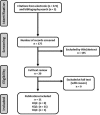The Effectiveness and Safety of Exoskeletons as Assistive and Rehabilitation Devices in the Treatment of Neurologic Gait Disorders in Patients with Spinal Cord Injury: A Systematic Review
- PMID: 27853668
- PMCID: PMC5110426
- DOI: 10.1055/s-0036-1593805
The Effectiveness and Safety of Exoskeletons as Assistive and Rehabilitation Devices in the Treatment of Neurologic Gait Disorders in Patients with Spinal Cord Injury: A Systematic Review
Abstract
Study Design Systematic review. Clinical Questions (1) When used as an assistive device, do wearable exoskeletons improve lower extremity function or gait compared with knee-ankle-foot orthoses (KAFOs) in patients with complete or incomplete spinal cord injury? (2) When used as a rehabilitation device, do wearable exoskeletons improve lower extremity function or gait compared with other rehabilitation strategies in patients with complete or incomplete spinal cord injury? (3) When used as an assistive or rehabilitation device, are wearable exoskeletons safe compared with KAFO for assistance or other rehabilitation strategies for rehabilitation in patients with complete or incomplete spinal cord injury? Methods PubMed, Cochrane, and Embase databases and reference lists of key articles were searched from database inception to May 2, 2016, to identify studies evaluating the effectiveness of wearable exoskeletons used as assistive or rehabilitative devices in patients with incomplete or complete spinal cord injury. Results No comparison studies were found evaluating exoskeletons as an assistive device. Nine comparison studies (11 publications) evaluated the use of exoskeletons as a rehabilitative device. The 10-meter walk test velocity and Spinal Cord Independence Measure scores showed no difference in change from baseline among patients undergoing exoskeleton training compared with various comparator therapies. The remaining primary outcome measures of 6-minute walk test distance and Walking Index for Spinal Cord Injury I and II and Functional Independence Measure-Locomotor scores showed mixed results, with some studies indicating no difference in change from baseline between exoskeleton training and comparator therapies, some indicating benefit of exoskeleton over comparator therapies, and some indicating benefit of comparator therapies over exoskeleton. Conclusion There is no data to compare locomotion assistance with exoskeleton versus conventional KAFOs. There is no consistent benefit from rehabilitation using an exoskeleton versus a variety of conventional methods in patients with chronic spinal cord injury. Trials comparing later-generation exoskeletons are needed.
Keywords: exoskeleton; rehabilitation; robotics; spinal cord injury.
Conflict of interest statement
Figures
Similar articles
-
Against the odds: what to expect in rehabilitation of chronic spinal cord injury with a neurologically controlled Hybrid Assistive Limb exoskeleton. A subgroup analysis of 55 patients according to age and lesion level.Neurosurg Focus. 2017 May;42(5):E15. doi: 10.3171/2017.2.FOCUS171. Neurosurg Focus. 2017. PMID: 28463613
-
Assistive powered exoskeleton for complete spinal cord injury: correlations between walking ability and exoskeleton control.Eur J Phys Rehabil Med. 2019 Apr;55(2):209-216. doi: 10.23736/S1973-9087.18.05308-X. Epub 2018 Aug 27. Eur J Phys Rehabil Med. 2019. PMID: 30156088
-
Systematic review on wearable lower-limb exoskeletons for gait training in neuromuscular impairments.J Neuroeng Rehabil. 2021 Feb 1;18(1):22. doi: 10.1186/s12984-021-00815-5. J Neuroeng Rehabil. 2021. PMID: 33526065 Free PMC article.
-
Comparing walking with knee-ankle-foot orthoses and a knee-powered exoskeleton after spinal cord injury: a randomized, crossover clinical trial.Sci Rep. 2022 Nov 9;12(1):19150. doi: 10.1038/s41598-022-23556-4. Sci Rep. 2022. PMID: 36351989 Free PMC article. Clinical Trial.
-
Wearable rehabilitation exoskeletons of the lower limb: analysis of versatility and adaptability.Disabil Rehabil Assist Technol. 2023 May;18(4):392-406. doi: 10.1080/17483107.2020.1858976. Epub 2020 Dec 17. Disabil Rehabil Assist Technol. 2023. PMID: 33332159 Review.
Cited by
-
Single-facility study of the effectiveness of rehabilitation therapy using wearable hybrid assistive limb for patients with bleeding disorders: study protocol for a randomised controlled trial.BMJ Open. 2023 Nov 19;13(11):e076153. doi: 10.1136/bmjopen-2023-076153. BMJ Open. 2023. PMID: 37984952 Free PMC article.
-
Enhancing rehabilitation and functional recovery after brain and spinal cord trauma with electrical neuromodulation.Curr Opin Neurol. 2019 Dec;32(6):828-835. doi: 10.1097/WCO.0000000000000750. Curr Opin Neurol. 2019. PMID: 31567546 Free PMC article. Review.
-
Physiotherapists' User Acceptance of a Lower Limb Robotic Exoskeleton in Specialized Rehabilitation: Qualitative Exploratory Study.JMIR Rehabil Assist Technol. 2025 Apr 16;12:e68233. doi: 10.2196/68233. JMIR Rehabil Assist Technol. 2025. PMID: 40238235 Free PMC article.
-
Effects of an Overground Walking Program With a Robotic Exoskeleton on Long-Term Manual Wheelchair Users With a Chronic Spinal Cord Injury: Protocol for a Self-Controlled Interventional Study.JMIR Res Protoc. 2020 Sep 24;9(9):e19251. doi: 10.2196/19251. JMIR Res Protoc. 2020. PMID: 32663160 Free PMC article.
-
Effectiveness of Robotic Devices for Medical Rehabilitation: An Umbrella Review.J Clin Med. 2024 Nov 4;13(21):6616. doi: 10.3390/jcm13216616. J Clin Med. 2024. PMID: 39518755 Free PMC article. Review.
References
-
- National Spinal Cord Injury Statistical Center Spinal Cord Injury (SCI) Facts and Figures at a Glance. 2016 Available at: https://www.nscisc.uab.edu/Public/Facts%202016.pdf. Accessed June 13, 2016
-
- Ditunno P L, Patrick M, Stineman M, Ditunno J F. Who wants to walk? Preferences for recovery after SCI: a longitudinal and cross-sectional study. Spinal Cord. 2008;46(7):500–506. - PubMed
-
- Aach M, Cruciger O, Sczesny-Kaiser M. et al.Voluntary driven exoskeleton as a new tool for rehabilitation in chronic spinal cord injury: a pilot study. Spine J. 2014;14(12):2847–2853. - PubMed
-
- Aach M, Meindl R C, Geßmann J, Schildhauer T A, Citak M, Cruciger O. [Exoskeletons for rehabilitation of patients with spinal cord injuries. Options and limitations] Unfallchirurg. 2015;118(2):130–137. - PubMed
-
- Kawamoto H, Sankai Y. Power assist method based on Phase Sequence and muscle force condition for HAL. Adv Robot. 2005;19(7):714–734.
LinkOut - more resources
Full Text Sources
Other Literature Sources


